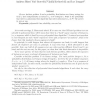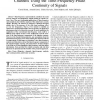64 search results - page 2 / 13 » Zero-One Frequency Laws |
IPL
1998
13 years 5 months ago
1998
Given a decision problem P and a probability distribution over binary strings, for each n, draw independently an instance xn of P of length n. What is the probability that there i...
JASIS
2002
13 years 5 months ago
2002
Fractional frequency distributions of e.g. authors with a certain (fractional) number of papers are very irregular and, therefore, not easy to model or to explain. This paper give...
COLING
2002
13 years 5 months ago
2002
Zipf's law states that the frequency of word tokens in a large corpus of natural language is inversely proportional to the rank. The law is investigated for two languages Eng...
TR
2011
13 years 18 days ago
2011
Abstract—Electric power transmission systems are a key infrastructure, and blackouts of these systems have major consequences for the economy and national security. Analyses of b...
TSP
2010
13 years 11 days ago
2010
Time-frequency representations constitute the main tool for analysis of nonstationary signals arising in real-life systems. One of the most challenging applications of time-frequen...


